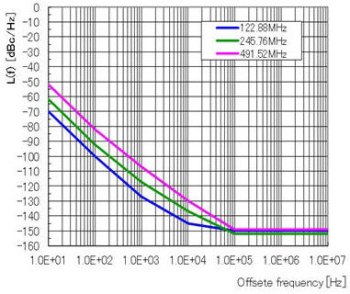Mar 11 2013
Epson Electronics America, Inc. (EEA) today announced that is has begun shipping samples of the VG-4513CB series of voltage controlled crystal oscillators (VCXO). Designed for optical networking and LTE (long-term evolution) base stations applications, the VG-4513CB uses a high-frequency fundamental(*1) crystal to achieve output frequencies up to 500 MHz with no spurs and very low phase noise and low jitter(*2).
 Figure 1. VG4513CB phase noise measured at 122.88, 245.76, and 491.52 MHz (Graphic: Business Wire)
Figure 1. VG4513CB phase noise measured at 122.88, 245.76, and 491.52 MHz (Graphic: Business Wire)
The VG-4513CB is packaged in a very small package, 87% smaller than existing VCXOs, and has excellent vibration sensitivity.
Epson’s VG-4513CB is the industry’s first VCXO to deliver output frequencies up to 500 MHz without using a PLL(*3) or frequency multiplier(*4). By using a high-frequency fundamental-mode AT-cut crystal, Epson achieves better reliability, lower power, and lower phase noise than existing 500 MHz VCXO products. Using a fundamental-mode crystal, Epson’s VG-4513CB achieves very low jitter, 50 fs rms at 491.52 MHz. Unlike PLLs and frequency multipliers, Epson’s fundamental technology does not generate spurs.
The high-frequency fundamental-mode crystal is fabricated using Epson’s QMEMS(*5) technology. QMEMS combines the superior material characteristics of Quartz with MEMS (Micro-Electrical Mechanical System) fabrication techniques. In addition to allowing reliable fundamental-mode oscillation, QMEMS enables size reduction of the VCXO and improves vibration sensitivity.
Epson’s VG-4513CB is delivered in a very small 5.0 mm x 3.2 mm x 1.3 mm package. Its footprint is 87% smaller than 14 mm x 9 mm VCXO products. This dramatic size reduction enables very dense designs such as multi-channel optical networking equipment and multi-channel MIMO (multiple input multiple output) LTE base stations.
Epson’s QMEMS technology enables Epson to improve vibration resistance three-fold over previous products. At a mere 0.6 ppb/g, Epson’s VG-4513CB provides a stable frequency reference for base stations which must be installed in challenging environments, such as near railroad tracks.
“With their compact design, high precision, and high stability, Epson’s new products will contribute to the success of LTE,” said Masayuki Morozumi, Executive Vice President and Chief Operating Officer of Epson's Microdevices Operations Division. "Epson will continue to leverage its QMEMS and semiconductor technologies to provide customers with powerful, easy-to-use solutions - and the peace of mind that goes with them."
Main characteristics of VG-4513CB VCXO series
1. Wide frequency range and low jitter
- Fundamental frequency oscillation
- Low jitter (12 kHz - 20 MHz)
- 122.88 MHz: 210 fs
- 245.76 MHz: 70 fs
- 491.52 MHz: 50 fs
Figure 1 shows measured phase noise for VG-4513CB at three common base station frequencies: 122.88, 245.76, and 491.52 MHz.
Figure 2 shows a spectrum analyzer measurement of VG-4513CB operating at 491.52 MHz. Because VG-4513CB uses fundamental-mode oscillation, it does not generate spurs.
By comparison, VCXOs using frequency multipliers generate sub-harmonic spurs, as shown in Figure 3.
2. Low G (vibration) sensitivity
G sensitivity: 0.6 ppb/g@at@ 245.76 MHz
3. Compact Package
Package size: 5.0mm x 3.2mm x 1.3mm Typ.
4. Pull Range
Epson's VG-4513CB is available in three pull ranges: ±30×10-6A±50×10-6, and ±100×10-6.
More information about Epson’s quartz devices:
http://www5.epsondevice.com/en/quartz/index.html
Glossary
*1: Fundamental frequency
The lowest (1st-order) frequency at which a quartz crystal resonator oscillates
*2: Jitter
Fluctuation among clock cycles, which can cause bit errors during data transfers.
*3: PLL (Phase Locked Loop)
An electronic circuit that locks an oscillator to the frequency of an input signal. PLLs can be used to multiply an input to a higher frequency, but they add jitter and spurs.
*4: Frequency multiplying
Multiplying the input frequency. Doubling the frequency is expressed as a 2x frequency multiplier, and tripling it as a 3x frequency multiplier, etc. Frequency multipliers can be used to generate high frequencies but they increase jitter and generate sub-harmonic spurs.
*5: QMEMS
QMEMS is a combination of “Quartz,” a crystalline material that has excellent stability and precision, and “MEMS,” micro electro-mechanical systems engineered using micro-fabrication technology. QMEMS devices, produced via a micro-fabrication process on a crystalline material, combine the advantages of MEMS technology with the fundamental superiority of Quartz. * QMEMS is a registered trademark of Seiko Epson Corporation.